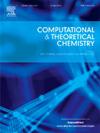Exploring the hydrogen interaction on Zn12O12 nanocages: A first-principles study
IF 3
3区 化学
Q3 CHEMISTRY, PHYSICAL
引用次数: 0
Abstract
This study uses density functional theory (DFT) a powerful computational method, to analyze how the hydrogen molecules adsorb in the Zn12O12 nanocage, a promising material for lightweight hydrogen storage applications. The adsorption mechanism is primarily governed by the charge redistribution and polarization effect originating from Zn![]() O bonds, which induce preferential binding of H2 molecules at Zn sites. Detailed electronic structure analysis, supported by Quantum Theory of Atoms in Molecules (QTAIM) and Non-covalent Interaction (NCI) calculations, reveals that these interactions are weakly physisorption yet highly stable, ensuring reversible adsorption. The compute average adsorption energy is approximately −0.04 eV per H2 molecule, indicating facile adsorption-desorption under ambient conditions. Zn12O12 nanocages demonstrate an impressive gravimetric hydrogen storage capacity exceeding 7.6 wt%, surpassing several current nanostructured materials. Furthermore, ab initio molecular dynamics (AIMD) simulations conducted at 300 K confirm the structural stability of Zn12O12 during H2 adsorption. To further enhance the tunability of Zn12O12 nanocage properties for hydrogen storage applications, alkali metal doping (Li, Na, K) was investigated by substituting a Zn atom with an alkali element. Structural optimization and stability assessments confirm that the doped nanocages preserve their geometric integrity, while molecular electrostatic potential (MEP) analysis reveals pronounced localized charge redistribution around the dopant site. Although the computed average H2 adsorption energies remain comparable to the pristine nanocage, the induction of alkali dopants generates chemically active regions that could facilitate tailored surface reactivity, enhance spillover processes, and enable applications specific functionalization. These findings provide deep insights into the H2 retention mechanisms within Zn12O12 clusters, highlighting their versatility and potential for next-generation hydrogen energy systems.
O bonds, which induce preferential binding of H2 molecules at Zn sites. Detailed electronic structure analysis, supported by Quantum Theory of Atoms in Molecules (QTAIM) and Non-covalent Interaction (NCI) calculations, reveals that these interactions are weakly physisorption yet highly stable, ensuring reversible adsorption. The compute average adsorption energy is approximately −0.04 eV per H2 molecule, indicating facile adsorption-desorption under ambient conditions. Zn12O12 nanocages demonstrate an impressive gravimetric hydrogen storage capacity exceeding 7.6 wt%, surpassing several current nanostructured materials. Furthermore, ab initio molecular dynamics (AIMD) simulations conducted at 300 K confirm the structural stability of Zn12O12 during H2 adsorption. To further enhance the tunability of Zn12O12 nanocage properties for hydrogen storage applications, alkali metal doping (Li, Na, K) was investigated by substituting a Zn atom with an alkali element. Structural optimization and stability assessments confirm that the doped nanocages preserve their geometric integrity, while molecular electrostatic potential (MEP) analysis reveals pronounced localized charge redistribution around the dopant site. Although the computed average H2 adsorption energies remain comparable to the pristine nanocage, the induction of alkali dopants generates chemically active regions that could facilitate tailored surface reactivity, enhance spillover processes, and enable applications specific functionalization. These findings provide deep insights into the H2 retention mechanisms within Zn12O12 clusters, highlighting their versatility and potential for next-generation hydrogen energy systems.

探索Zn12O12纳米笼上氢相互作用:第一性原理研究
本研究利用密度泛函理论(DFT)这一强大的计算方法,分析了氢分子在Zn12O12纳米笼中的吸附情况,Zn12O12纳米笼是一种有前景的轻质储氢材料。吸附机制主要是由ZnO键引起的电荷重分配和极化效应决定的,它们诱导H2分子在Zn位点优先结合。在分子原子量子理论(QTAIM)和非共价相互作用(NCI)计算的支持下,详细的电子结构分析表明,这些相互作用是弱物理吸附但高度稳定的,确保了可逆吸附。计算平均吸附能约为- 0.04 eV / H2分子,表明在环境条件下易于吸附-解吸。Zn12O12纳米笼表现出令人印象深刻的重量储氢容量,超过7.6%,超过了目前几种纳米结构材料。此外,在300 K下进行的从头算分子动力学(AIMD)模拟证实了Zn12O12在H2吸附过程中的结构稳定性。为了进一步提高Zn12O12纳米笼储氢性能的可调性,研究了碱金属掺杂(Li, Na, K)的方法,用碱金属取代Zn原子。结构优化和稳定性评估证实,掺杂的纳米笼保持了其几何完整性,而分子静电势(MEP)分析显示,掺杂位点周围的局部电荷重新分布明显。虽然计算出的平均H2吸附能与原始纳米笼相当,但碱掺杂剂的诱导产生的化学活性区域可以促进定制的表面反应性,增强溢出过程,并实现特定的应用功能化。这些发现为Zn12O12簇中的H2保留机制提供了深入的见解,突出了它们的多功能性和下一代氢能系统的潜力。
本文章由计算机程序翻译,如有差异,请以英文原文为准。
求助全文
约1分钟内获得全文
求助全文
来源期刊

Computational and Theoretical Chemistry
CHEMISTRY, PHYSICAL-
CiteScore
4.20
自引率
10.70%
发文量
331
审稿时长
31 days
期刊介绍:
Computational and Theoretical Chemistry publishes high quality, original reports of significance in computational and theoretical chemistry including those that deal with problems of structure, properties, energetics, weak interactions, reaction mechanisms, catalysis, and reaction rates involving atoms, molecules, clusters, surfaces, and bulk matter.
 求助内容:
求助内容: 应助结果提醒方式:
应助结果提醒方式:


